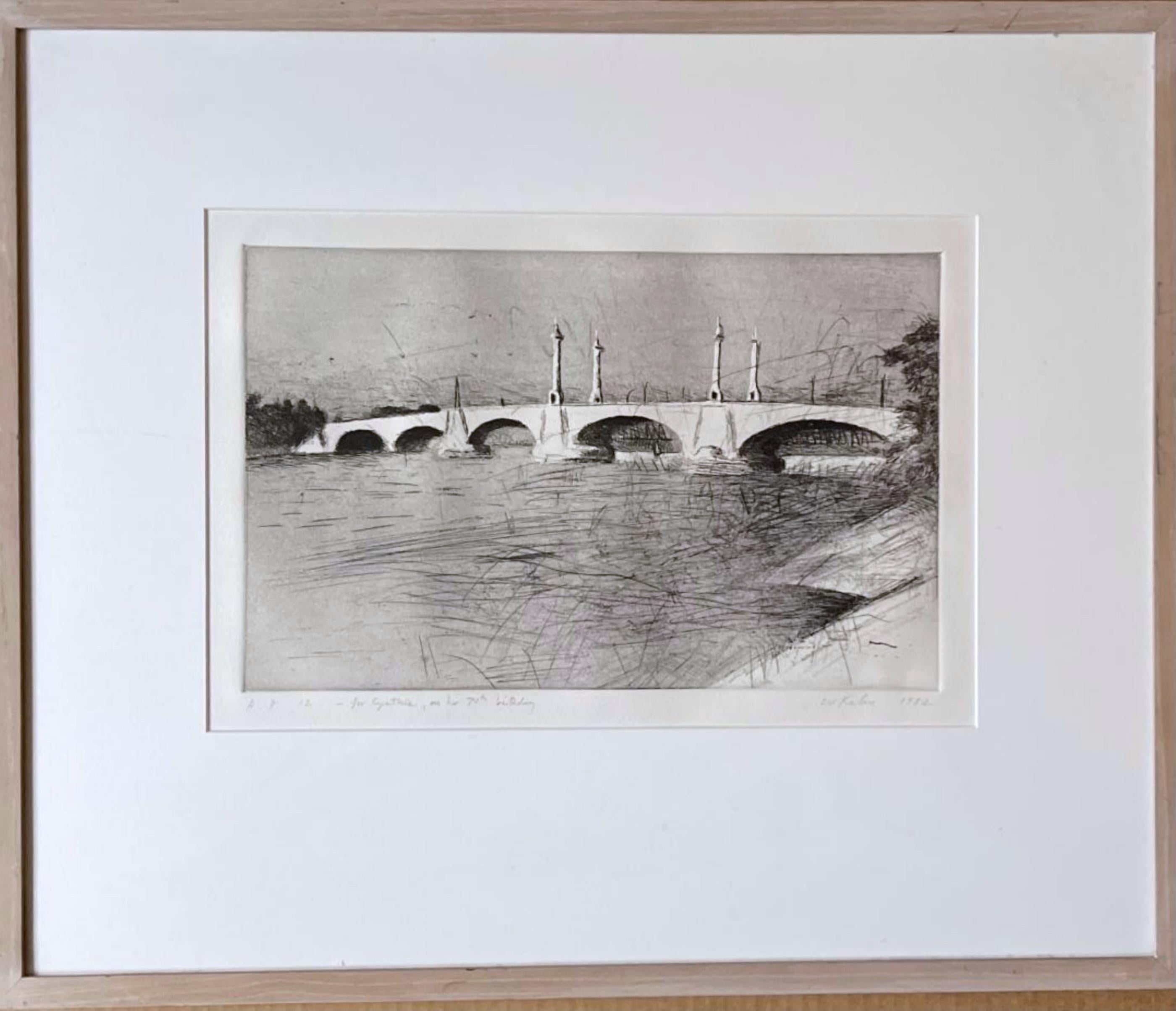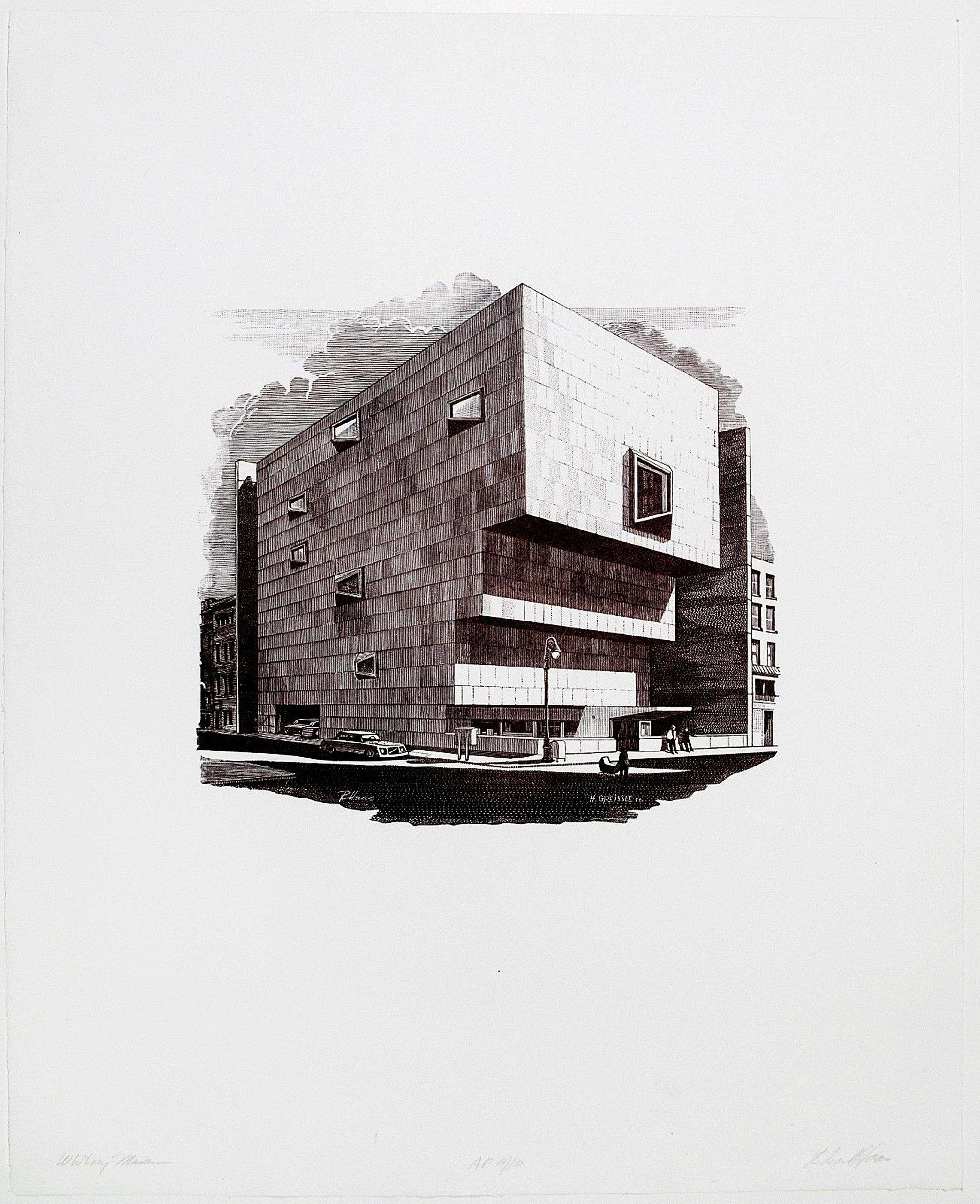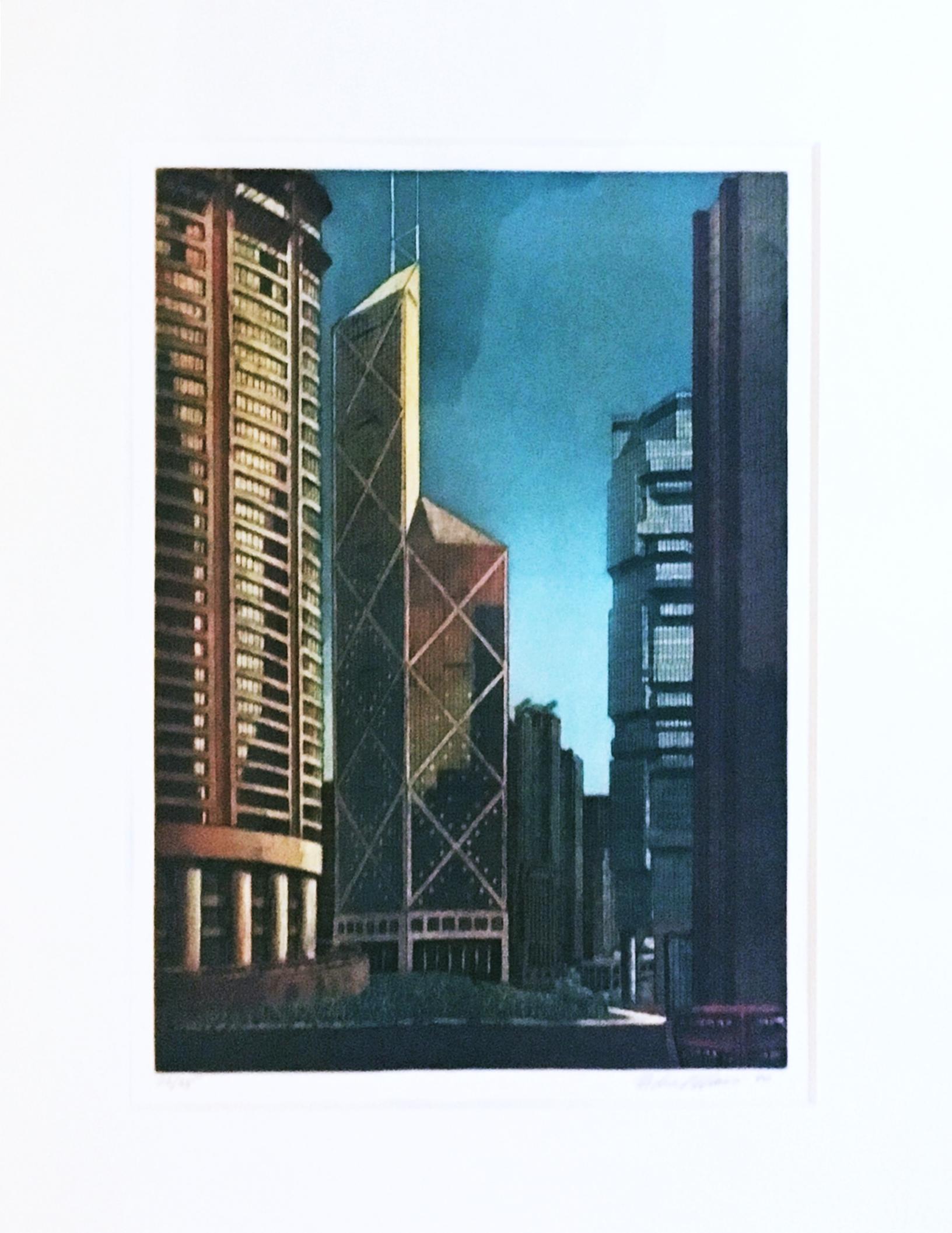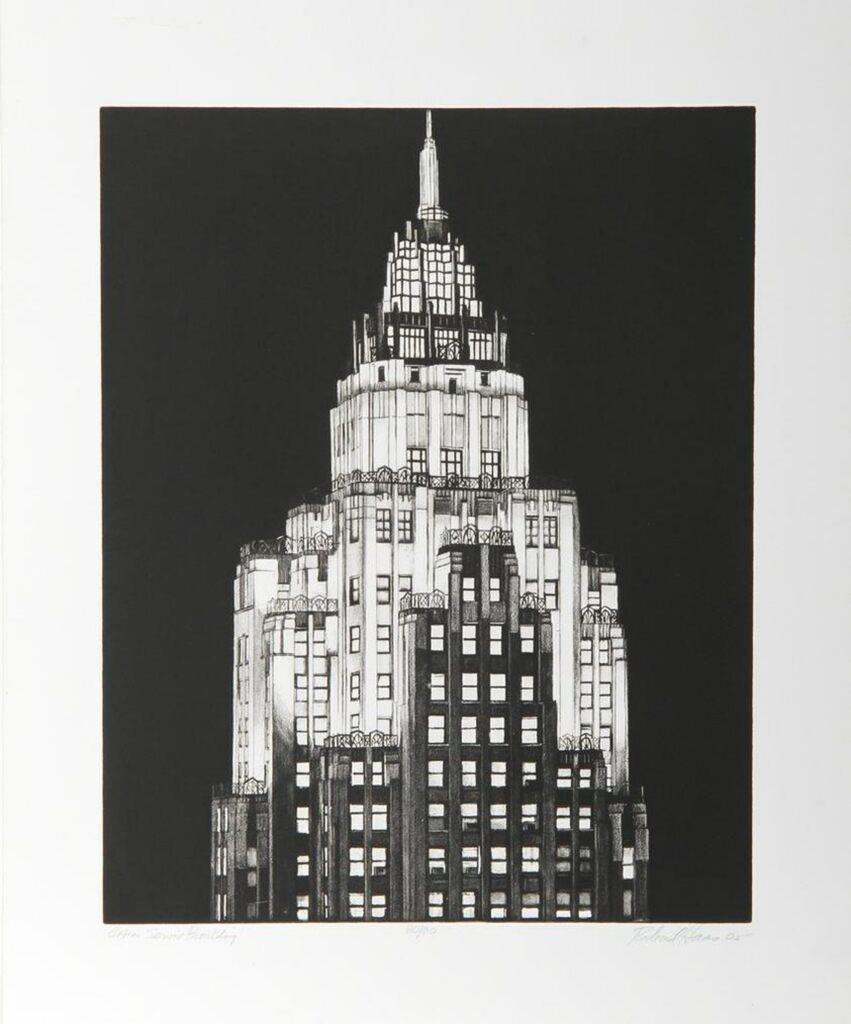Items Similar to View of a coastal town / - The Pilgrim's View -
Want more images or videos?
Request additional images or videos from the seller
1 of 8
Albert ErnstView of a coastal town / - The Pilgrim's View -
About the Item
Albert Ernst (1909 Fronhofen - 1996 Hamburg), View of a Coastal Town, etching, 30 x 37 cm (picture), 45 x 50.5 cm (frame), signed in pencil lower right "Albert Ernst", framed under glass.
- very good condition and attractively framed
- The Pilgrim's View -
About the artwork
Standing on a hill, we look at a bay with a town. The foreground of the picture is only slightly worked out, so that our gaze is completely absorbed in the view framed by trees. Up to the middle of the picture, the landscape is kept in a darker tonality, while the city appears brighter and the sea really shines. This brightening in the distance also focuses the view and makes the seaside city a place of longing. Accordingly, on closer inspection, we can make out a pilgrim in front of the dark thicket, walking from the foreground of the picture along the dark, hollow path that leads to the city. As the goal of his pilgrimage, a mighty church tower rises in the center of the picture, from which the shore of the sea on the other side and thus the goal of the pilgrimage of life may be recognizable.
About the artist
Albert Ernst studied at the Academy of Applied Arts in Munich from 1932-1936 and was an assistant there from 1936-1941. He then worked as a freelance graphic artist, first in Munich until 1950 and then in Hamburg. In Hamburg he was also commissioned to design church windows for sacred buildings in Steilshoop, Bramfeld and Stellingen from 1977-1979.
Selected bibliography
Sauer. Allgemeines Künstler-Lexikon, Vol. 34, Munich - Leipzig 2002, p. 444.
GERMAN VERSION
Albert Ernst (1909 Fronhofen - 1996 Hamburg), Blick auf eine Küstenstadt, Radierung, 30 x 37 cm (Darstellung), 45 x 50,5 cm (Rahmen), rechts unten in Blei mit „Albert Ernst“ signiert, im Passepartout unter Glas gerahmt.
- sehr gut erhalten und ansprechend gerahmt
- Der pilgernde Blick -
zum Kunstwerk
Auf einer Anhöhe stehend, blicken wir auf eine Meeresbucht mit einer Stadt. Der vordere Bildbereich ist nur andeutungsweise ausgearbeitet, so dass unser Blick ganz in dem von Bäumen gerahmten Ausblick aufgeht. Bis in den Bildmittelgrund hinein ist die Landschaft in einer dunkleren Tonalität gehalten, während die Stadt heller erscheint und das Meer regelrecht aufstrahlt. Auch durch diese Aufhellung in die Ferne hinein wird der Blick auf die Aussicht fokussiert und die Stadt am Meer zum Sehnsuchtsort. Entsprechend können wir bei genauerem Hinsehen vor dem dunklen Dickicht einen Pilger erkennen, der vom Bildvordergrund aus den dunklen zur Stadt führenden Hohlweg entlangläuft. Als Ziel seiner Pilgerschaft erhebt sich in der Bildmitte ein mächtiger Kirchturm, von dem aus das jenseitige Ufer des Meeres und damit das Ziel der Pilgerschaft des Lebens zu erkennen sein mag.
zum Künstler
Albert Ernst studierte von 1932-1936 an der Akademie für angewandte Kunst in München und war dort von 1936-1941 als Assistent beschäftigt. Anschließend war er als freier Grafiker tätig, bis 1950 in München und anschließend in Hamburg. In Hamburg wurde er in den Jahren 1977-1979 auch mit der Gestaltung von Kirchenfenstern für Sakralbauten in Steilshoop, Bramfeld und Stellingen betreut.
Auswahlbibliographie
Sauer. Allgemeines Künstler-Lexikon, Band 34, München - Leipzig 2002, S. 444.
- Creator:Albert Ernst (1909 - 1996, German)
- Dimensions:Height: 17.72 in (45 cm)Width: 20.08 in (51 cm)Depth: 0.79 in (2 cm)
- Medium:
- Movement & Style:
- Period:
- Condition:
- Gallery Location:Berlin, DE
- Reference Number:1stDibs: LU2438212429202

About the Seller
5.0
Vetted Seller
These experienced sellers undergo a comprehensive evaluation by our team of in-house experts.
Established in 2014
1stDibs seller since 2023
7 sales on 1stDibs
Typical response time: 7 hours
- ShippingRetrieving quote...Ships From: Berlin, Germany
- Return PolicyA return for this item may be initiated within 14 days of delivery.
More From This SellerView All
- Agony - The architecture of decay -Located in Berlin, DEJörg Olberg (*1956 Dresden), Agony, 1987. etching, E.A. (edition of 30), 24 x 17 cm (image), 46 x 37 cm (sheet), each signed in pencil lower right "Olberg" and dated "IX [19]87", inscribed lower left "E.A. [Epreuve d'Artiste]". - minimal crease and dust stains in the broad margin - The architecture of decay - About the artwork Jörg Olberg draws here the sum of his artistic study of the Berlin ruins, which were still present in the cityscape well into the 80s. With his work "Agony" he creates an allegory of decay. Positioned in the landscape of ruins, a ruined house grows before the viewer, rising like the Tower of Babel into the sky, its roof and gable brightly illuminated by the sun. But already the roof shows mostly only the rafters, and as the gaze is drawn further down, the building visibly disintegrates, the beams protruding in all directions looking like splintered bones. Slowly but inexorably - in agony - the house will collapse in on itself and become nothing more than the burial mound of itself. At the same time, the small-scale stone composition and the plaster form a pattern-like ornamentation of decay. The tension in the picture is fed by the counter-movement of growth and collapse, which is heightened by the dramatic formation of clouds. The swirls of clouds are reminiscent of a world landscape...Category
1980s Realist Figurative Prints
MaterialsEtching, Paper
- The Lost TraceBy Ernst FuchsLocated in Berlin, DEErnst Fuchs (1930 Vienna - 2015 ibid), The Lost Trace, 1972. Vernis mou and aquatint etching, 46.8 x 36.4 cm (plate), 66 x 50 cm (sheet), 69.5 x 53.5 cm (frame), WVZ Hartmann no. 185...Category
1970s Surrealist Figurative Prints
MaterialsEtching
- Evening - The depth of the visible -Located in Berlin, DEMax Clarenbach (1880 Neuss - Cologne 1952), Evening. Etching, 18 x 41 cm (platemark), 33.5 x 57 cm (frame), inscribed "Abend" in pencil at lower left, signed and dated "M. Clarenbach. 28.III.[19]09". Framed and mounted under glass. - Somewhat browned and slightly foxed. About the artwork The horizontally elongated etching depicts the panoramic view of a small town as seen from the other side of the river. There are gabled houses on the left and a mighty church spire on the right. The bourgeois houses and the large religious building indicate the urban character. These buildings are rendered in dark tones to emphasise the lighter row of houses in the centre of the picture, closer to the water. The chiaroscuro contrast creates two parallel planes that open up a space for the imagination of what the city could be. The imagination is stimulated by the almost entirely dark, barely recognisable buildings, while the arm of the river leading into the city further stimulates the imagination. However, as the silhouette of the city as a whole is reflected in the water, the parallel planes are perceived as a band of houses that stretches across the entire horizontality of the etching and seems to continue beyond the borders of the picture. The reflection has almost the same intensity as the houses themselves, so that the band of buildings merges with their reflection to form the dominant formal unit of the picture. Only the parallel horizontal hatching creates the convincing impression of seeing water, demonstrating Max Clarenbach's mastery of the etching needle. The water is completely motionless, the reflection unclouded by the slightest movement of the waves, creating a symmetry within the formal unity of the cityscape and its reflection that goes beyond the motif of a mere cityscape. A pictorial order is established that integrates everything in the picture and has a metaphysical character as a structure of order that transcends the individual things. This pictorial order is not only relevant in the pictorial world, but the picture itself reveals the order of the reality it depicts. Revealing the metaphysical order of reality in the structures of its visibility is what drives Clarenbach as an artist and motivates him to return to the same circle of motifs. The symmetry described is at the same time inherent an asymmetry that is a reflection on art: While the real cityscape is cut off at the top of the picture, two chimneys and above all the church tower are not visible, the reflection illustrates reality in its entirety. The reflection occupies a much larger space in the picture than reality itself. Since antiquity, art has been understood primarily as a reflection of reality, but here Clarenbach makes it clear that art is not a mere appearance, which can at best be a reflection of reality, but that art has the potential to reveal reality itself. The revealed structure of order is by no means purely formalistic; it appears at the same time as the mood of the landscape. The picture is filled with an almost sacred silence. Nothing in the picture evokes a sound, and there is complete stillness. There are no people in Clarenbach's landscape paintings to bring action into the picture. Not even we ourselves are assigned a viewing position in the picture, so that we do not become thematic subjects of action. Clarenbach also refrains from depicting technical achievements. The absence of man and technology creates an atmosphere of timelessness. Even if the specific date proves that Clarenbach is depicting something that happened before his eyes, without the date we would not be able to say which decade, or even which century, we are in. The motionless stillness, then, does not result in time being frozen in the picture, but rather in a timeless eternity that is nevertheless, as the title "Abend" (evening), added by Clarenbach himself, makes clear, a phenomenon of transition. The landscape of the stalls is about to be completely plunged into darkness, the buildings behind it only faintly discernible. The slightly darkened state of the sheet is in keeping with this transitional quality, which also lends the scene a sepia quality that underlines its timelessness. And yet the depiction is tied to a very specific time. Clarenbach dates the picture to the evening of 28 March 1909, which does not refer to the making of the etching, but to the capture of the landscape's essence in the landscape itself. If the real landscape is thus in a state of transition, and therefore something ephemeral, art reveals its true nature in that reality, subject to the flow of phenomena, is transferred to an eternal moment, subject to a supra-temporal structure of order - revealed by art. Despite this supratemporality, the picture also shows the harbingers of night as the coming darkening of the world, which gives the picture a deeply melancholy quality, enhanced by the browning of the leaf. It is the philosophical content and the lyrical-melancholic effect of the graphic that give it its enchanting power. Once we are immersed in the image, it literally takes a jerk to disengage from it. This etching, so characteristic of Max Clarenbach's art, is - not least because of its dimensions - a major work in his graphic oeuvre. About the artist Born into poverty and orphaned at an early age, the artistically gifted young Max Clarenbach was discovered by Andreas Achenbach and admitted to the Düsseldorf Art Academy at the age of 13. "Completely penniless, I worked for an uncle in a cardboard factory in the evenings to pay for my studies.” - Max Clarenbach At the academy he studied under Arthur Kampf, among others, and in 1897 was accepted into Eugen Dücker...Category
Early 1900s Realist Landscape Prints
MaterialsEtching
- General Wilhelm von Blume - Visionary retrospective -Located in Berlin, DEBernhard Pankok (1872 Münster - 1943 Baierbrunn), General Wilhelm von Blume, 1915, aquatint etching, 34 x 29.5 cm (sheet size), 26 x 22 cm (plate size), signed in the plate at upper left, in pencil at lower right and dated in pencil at lower left. - At lower left old collection stamp, at the right broad margin with a small spot, otherwise very good condition. About the artwork The 1915 aquatint etching of General Wilhelm von Blume is based on a 1912 oil painting in the LWL-Museum für Kunst und Kultur in Münster. A second oil portrait of the general by Pankok is in the Staatsgalerie Stuttgart. When Pankok painted the first oil portrait in 1912, the general had already been retired for 16 years. It is therefore a retrospective portrait. Accordingly, the orientation of his head is such that he is looking back in both the oil painting and the etching. Without fixing on anything in particular, he looks thoughtfully inwards and reflects on his life. Uniformed and highly endowed, it is his military activities in particular that he is reviewing attentively and, as his gaze reveals, quite critically. Pankok has literally written the sum of his experiences on Wilhelm von Blume's face: The physiognomy is a veritable landscape of folds, furrows, ridges and gullies, all the more striking against the flat background. It is clear that each of the medals was also won through suffering. However, by breaking the boundaries of the picture, his bust appears as an unshakable massif, which gives the general a stoic quality. The fact that the design of the portrait was important to Pankok can be seen from the different versions, the present sheet being the third and probably final revision, which Pankok dates precisely to 18 February 1915. Compared with the previous state, the light background now has a dark area against which the sitter's face stands out, the dark background in turn combining with the uniform to create a new tension in the picture. Pankok's taking up of the portrait of the high-ranking military veteran and its graphic reproduction can also be seen in relation to the First World War, which had broken out in the meantime. In the face of modern weapons of mass destruction, Wilhelm von Blume's warfare and military writings were relics of a bygone, more value-oriented era. About the artist After studying at the Düsseldorf Art Academy from 1889 to 1891 under Heinrich Lauenstein, Adolf Schill, Hugo Crola, and Peter Janssen the Elder, Bernhard Pankok went to Munich in 1892, where he worked primarily as a graphic artist for the two major Jugendstil magazines "Pan" and "Jugend," which established his artistic success. Through this work he met Emil Orlik, with whom he had a lifelong friendship. In 1897, he exhibited his first furniture, and in 1898, together with Richard Riemerschmid, Bruno Paul and Hermann Obrist...Category
1910s Realist Portrait Prints
MaterialsEtching
- Balaclava - The target in sight -Located in Berlin, DEHeinrich Haberl (1869 Passau to 1934 Munich), Sturmhaube, c. 1900. drypoint, 14 x 10 cm (platemark), 28 x 21 cm (sheet size), 39 x 29 cm (passe-partout), titled "Sturmhaube" in lead at lower left and inscribed "Kaltnadelradierung", signed and locally inscribed "Heinrich Haberl Mchn. [Munich]" at lower right, inscribed again in lead on verso and with old collection stamp. - slightly darkened, fixed and mounted - The target in sight - About the artwork The theatrical "role-portrait" is to be seen against the background of the Rembrandt cult, which reached its climax at the end of the 19th century. The soldier seems to have stepped straight out of Rembrandt's Night Watch (1642) to fix something outside the picture with an alert and ready gaze. The steeply rising brim of the morion frames the gaze and thus perspectivises it as the actual 'pictorial action'. The gaze represents both the vigilant defence and the visionary goal of the battle. Not only the subject, but also the style of the etching needle reflect Rembrandt's understanding of the times. Strong contrasts of light and dark are created in a virtuoso free stroke, without losing the effect of the reflections on the helmet and in the eyes. This shows a kinship with the early prints of Lovis Corinth, who also saw himself as an artist in the role of the knight. Against this background, Haberl's picture can also be seen as a representation of his artistic self-image. About the artist Heinrich Haberl first attended the art school in Nuremberg and from 1892 studied at the Munich Academy. There he was a master student of Johann Leonhard von Raab, Rudolf von Seitz, Franz von Defregger...Category
Early 19th Century Realist Figurative Prints
MaterialsEtching
- The Talisman (so called Dukatenscheisser) - The philosopher's stone -By Carl PlückebaumLocated in Berlin, DECarl Maria Plückebaum (1880 Düsseldorf - 1952 ibid.), Der Talismann (sog. Dukatenscheisser), partly colored etching, 11.5 x 8.5 cm (plate size), 26.5 x 20 cm (sheet size), signed by hand below the image on the right "C. Plückebaum" and inscribed by hand at lower left "Der Talismann". - left and right side of the sheet with browned stripes, otherwise good copy - The philosopher's stone - About the artist Here, Carl Plückebaum gives free rein to his anti-academic impulses and turns the subtle humor of his pictures into crudeness. Following Adrian Ostade's peasants as they go about their needy business, we see a cowardly fellow in a squatting position. His excrement, however, is not the organic remains of digestion, but - like the golden donkey in the Grimm fairy tale - ducats. However, they appear more brown than golden, which is emphasized by the discreet hand-coloring of the picture. The unattractive accumulation is countered by the blossoms decorating the crouching man's hat. Totally absorbed in his action, his activity is evident in the strained expression on his face, giving Plückebaum a whole new verisimilitude to the concept of naturalism. The title "The Talisman" then turns naturalism back to the miraculous, formulating in a humorous way that these legacies are also a "miracle of nature". About the artist Coming from a poor background, Carl Plückebaum, who had a walking disability and was of short stature, initially worked as a church restorer. He also took private drawing lessons. In 1901 he won the first prize of the Düsseldorf Museum of Decorative Arts, which enabled him to finance his studies at the Düsseldorf Academy. There he was a pupil of Eduard von Gebhardt and Peter Janssen the Elder, but began to doubt the academic teaching. In 1906 he took part in a group exhibition at the Städtische Kunsthalle Düsseldorf, which violated the academy's statutes and led to his dismissal. However, the extraordinary success with the public confirmed him as an artist and provided him with the financial means for a study trip to Italy. Enchanted by Florence, he retired to the Franciscan monastery of Fisole, where he worked as a fresco painter. Back in Düsseldorf, he turned increasingly to children's and animal drawings, and in 1907 he was a founding member of the Niederrhein Secessionist Artists' Group. In 1910 he travelled to Italy again, accompanied by his painter friends Walter Ophey and Carl Schmitz-Pleis, visiting Rome and Naples in particular. He then stayed in Munich to study the Old Masters at the Pinakothek. It was in the artistic circles of Schwabing that he met his future wife, the painter Meta Weber. In Düsseldorf, Carl and Meta Plückebaum...Category
Early 20th Century Realist Figurative Prints
MaterialsEtching
You May Also Like
- New York City Skyline Modern Print Chrysler State Building Framed Unique EtchingBy Katherine GallagherLocated in Buffalo, NYLimited edition aquatint etching of the New York City skyline by Katherine E. Gallagher. This piece features the famous Chrysler Building prominently in the background along with a M...Category
1980s Realist Landscape Prints
MaterialsEtching, Aquatint
- Memorial Bridge, Springfield, MassBy Wolf KahnLocated in New York, NYWolf Kahn Untitled, 1982 Original Etching 10 × 15 inches Edition AP (aside from the regular edition of 90) pencil signed, dated and inscribed to Cynthia Frame included: Ships framed...Category
1980s Realist Landscape Prints
MaterialsEtching
- The Whitney (Marcel Breuer Building)By Richard HaasLocated in New York, NYRichard Haas The Whitney (Marcel Breuer Building), 1979 Woodcut engraving Signed, titled, dated and numbered by the artist on the back. This is a rare Artist Proof 9/10, aside from the regular edition of 60. 22 3/4 × 18 1/4 inches Unframed This vintage 1979 woodcut engraving by the world's top architectural muralist and trompe d'oeil artist, Richard Haas, depicts the building New Yorkers nostalgically call the "Old Whitney". Long before the Whitney moved to Manhattan's trendy meatpacking district...Category
1970s Realist Figurative Prints
MaterialsEngraving, Etching
- Hong KongBy Richard HaasLocated in New York, NYRichard Haas Hong Kong, 1990 Etching and Aquatint on wove paper Hand Signed, numbered and dated on the front Frame included; held in the original vintage hand made wood frame done by PSG This impressive, framed lithograph of Hong Kong is by Richard Haas - the world's foremost architectural muralist and trompe l'oeil artist whose prints and paintings are held and exhibited in many private, public and institutional collections. It is framed and ready to hang. Haas - who, aside from his many artistic distinctions, was profiled several years back by the prestigious CBS News...Category
1990s Realist Figurative Prints
MaterialsEtching, Aquatint
- Puck Corner, SOHO, New York signed & numbered 10/100 by top architectural artistBy Richard HaasLocated in New York, NYRichard Haas Puck Corner, SOHO, New York, 1971 Etching and Aquatint (affixed to white matting) Hand signed and numbered 10/100 by the artist on the lower front 19 3/5 × 16 1/2 inches Unframed in white matting; ready to be re-framed and hung. Puck Corner refers to the famous Puck building located on the corner of Broome and Broadway in SoHo, Manhattan: "The Puck Building is a historic building located in the Nolita neighborhood of Manhattan, New York City. This New York City Landmark is located at the northwestern corner of Manhattan's NoLIta neighborhood, bordered by SoHo and the NoHo section of Greenwich Village. The building was the longtime home of Puck magazine, which gave the building its name; Founded in St. Louis in 1871, the magazine moved into the building in 1887 and remained there until it ceased publication in 1918. Other famous tenants include Spy Magazine and the Manhattan Center of Pratt Institute. Since 2004, the building has been used by New York University for the Wagner Graduate School of Public Service and the department of sociology. In 2011, REI opened a 35,000-square-foot store...Category
1970s Realist Figurative Prints
MaterialsEtching, Aquatint, Pencil
- City Service Building (70 Pine Street, Manhattan)By Richard HaasLocated in New York, NYRichard Haas City Service Building (70 Pine Street, Manhattan), 2005 Etching Signed, titled, dated and numbered 7/20 in pencil on the front 20 × 16 inches Unframed Rare print by Rich...Category
Early 2000s Realist Landscape Prints
MaterialsEtching, Pencil





